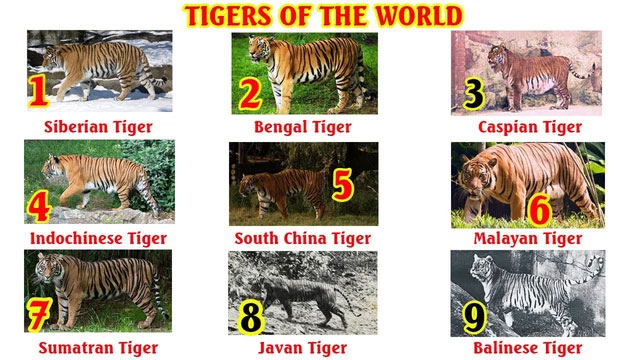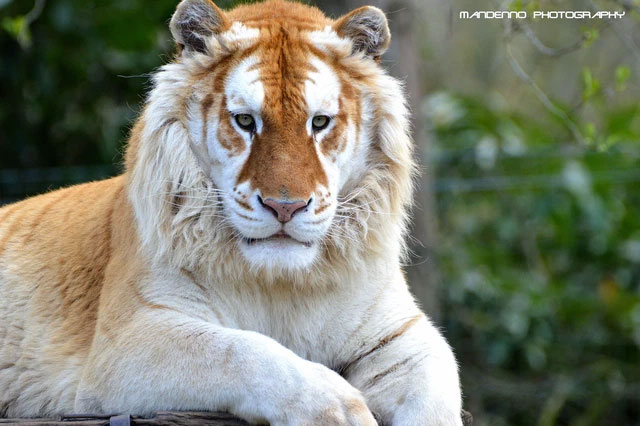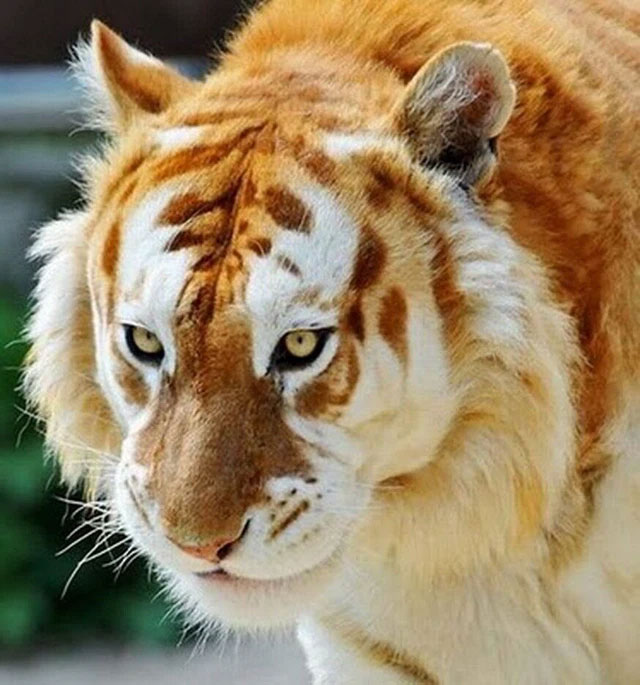According to the World Wildlife Fund (WWF), modern tigers have 9 subspecies. However, there are individuals that possess appearances and colors completely different from the 9 known subspecies, and these are regarded as mutant tigers.
Tigers are a species that has been present in the ancient cultures of Asian countries, especially in Vietnam, where they have always been an object of fear and their image often symbolizes strength and courage. The White Tiger is one of the four sacred beasts in Vietnamese and Chinese mythology, and it is also considered a divine beast of the West, originating from ancient star worship.
Unlike most mythological animals, the White Tiger actually exists in real life. This is a rare variant of the tiger species, primarily showing that the original orange base color has turned white.
In fact, this type of mutant tiger is not only white but also includes pure white tigers, snow tigers, yellow tigers, and so on. Notably, the yellow tiger is one of the four extremely rare mutations in the tiger species.

The White Tiger actually exists in real life.
Basic Classification of Tigers
International mainstream theory believes that tigers appeared on Earth about 2 million years ago, and by 110,000 years ago, they rapidly spread across the Asian continent, undergoing habitat isolation, climate change, genetic drift, and natural selection, gradually differentiating into many subspecies.
Even including extinct species, modern tigers can be divided into 9 subspecies: Siberian tiger, South China tiger, Bengal tiger, Indochinese tiger, Malayan tiger, Sumatran tiger, Javan tiger, Balinese tiger, and Caspian tiger. Among these 9 types of tigers, the subspecies living inland tend to be larger than those living on islands.

The species marked in black are extinct.
The ancestors of modern tigers are ancient Chinese cats. In 2015, a DNA study confirmed that the South China tiger is the oldest branch of modern tigers, affirming the hypothesis that modern tigers originated from East Asia.
After the emergence of modern tigers, there were virtually no super-large predators on Earth that could compete with them, allowing tigers to spread rapidly and laying the foundation for future subspecies differentiation.
In fact, in the primordial Earth environment, the distribution patterns of land and islands were not as we see them now; they might have been separated by shallow trenches or even connected by land bridges. Only during subsequent environmental changes did these land bridges become submerged, and trenches transformed into straits. Hence, we have subspecies of tigers living on islands rather than on the mainland.

The ancestors of modern tigers are ancient Chinese cats.
Mutant Tigers
From the 9 subspecies of tigers mentioned above, it is clear that the white tiger is very distinct. So, what subspecies is the white tiger?
In fact, the white tiger is not an independent subspecies but rather a harmless gene mutation of the normal tiger, specifically a harmless gene mutation that does not affect the body except for changes in fur color.
Of course, this type of mutation is very difficult to survive in the wild because it is too conspicuous, leading to less effective hunting, and it can easily starve. Currently, white tigers only exist among Bengal tigers, and the probability of white tigers appearing in artificial captive environments is much higher than in the wild.

The white tiger is not an independent subspecies but a gene mutation.
Due to the gene mutation, the tiger lacks methyl ester of phenylalanine, resulting in its white fur color, but its black stripes remain unaffected, so the overall appearance of the white tiger primarily consists of brown stripes on a white background. Aside from color, they are no different from a normal Bengal tiger.

The snow tiger is another variant based on the white tiger.
The snow tiger is another variant based on the white tiger, with the main characteristic being that even its stripes are much lighter, almost white, but if you look closely, you can still see the shadow of the stripes.
Similar to the pure white tiger, as its name suggests, it has a pure white color, and the markings on its body also turn white. The yellow tiger is a beautiful variant of the tiger, primarily displaying light brown stripes on a yellow background.

The yellow tiger is a beautiful variant of the tiger, primarily displaying light brown stripes on a yellow background.
The white tiger is a recessive gene mutation, with a very low probability of occurrence, approximately one case occurs for every 10,000 tiger cubs. Some may ask, since mutant tigers are so rare, why are they often seen in zoos?
Almost all white tigers survive in zoos in most major cities, primarily for economic reasons. Normal tigers are well-known and not particularly intriguing, while those with more unusual appearances naturally attract more attention.
Since the white trait is a manifestation of a recessive gene, if two white tigers are used as parents, their offspring will also be white tigers.

The probability of the yellow tiger appearing is much lower than that of the white tiger.
Compared to the white tiger, the probability of the yellow tiger appearing is even lower. Under the influence of gene mutation, its original orange fur color becomes bright yellow, and the originally dark brown patches turn light brown. The white fur on its belly grows longer, creating a stunning overall appearance.
By observing the appearance of the yellow tiger, some scholars believe it may be the prototype of Guoshan Huang in the legend of Shennong.
According to legend, Guoshan Huang is as large as a tiger, looks like a tiger, and moves swiftly across mountains like the wind, leaving only a golden afterimage.

Generally, mutant tigers rarely survive to full adulthood.
In the past, a South China tiger in Shennongjia may have given birth to a genetically mutated yellow tiger cub. Although it is considered a harmless mutation, due to its conspicuous appearance and difficulty in hunting compared to normal individuals, they cannot compete with other tigers. Thus, they can only live in areas with favorable living conditions, increasing the likelihood of encountering humans. However, mutant tigers generally rarely survive to full adulthood due to the many challenges they face in hunting.


















































